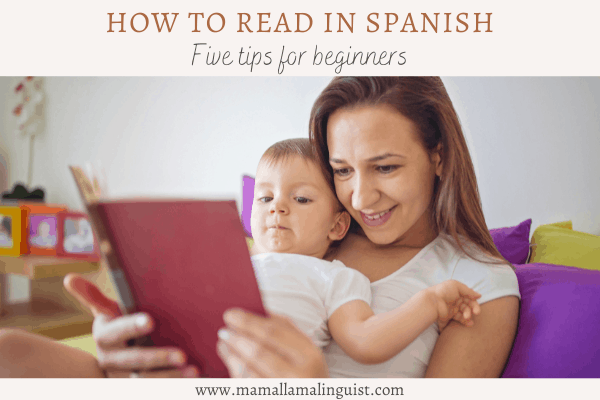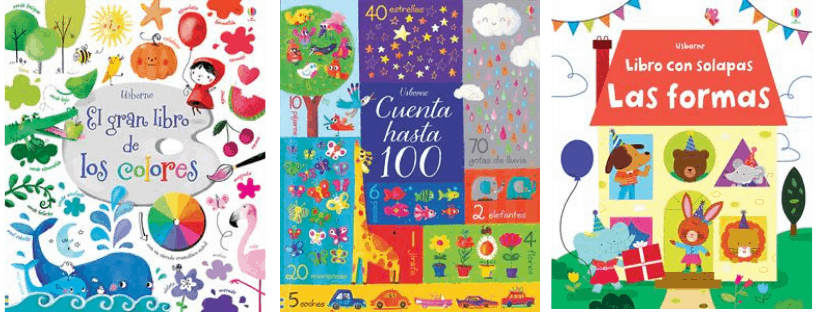In this post: Learn how to read to your child in Spanish, including Spanish books for beginners and the Montessori Three Period Lesson.
Reading aloud in Spanish, can be a little intimidating if you are not familiar with the language or pronunciation.
More than that, you may be wondering how you can keep your child engaged while you read aloud.
In this post I’m sharing FIVE tips for reading in Spanish for beginners. These hacks for language acquisition and engagement were a game changer for my children.

This post contains affiliate links for your convenience. Please read my Disclaimer for more information.
Psst…If your child is starting to learn to read, then check out this post on Spanish Leveled Books! We also have FREE First Spanish Readers in our Freebie Library.
Table of Contents
Choosing your First Spanish Books
With so many Spanish children’s titles out there, selecting books to introduce a new language can be a daunting task!
In selecting books, we of course want to ensure that they are age/level appropriate (think illustrations to words ratio and quantity of words per page). We also want to look for beautiful illustrations~ for engagement!
But here are two more important features I recommend looking for in choosing beginner Spanish books for kids:
Related: Best Children’s Spanish Beginners Books
Tip 1: Read Thematic Spanish Books
I love themed learning! It works wonders for teaching a second language too because it helps break down vocabulary learning into bitesize, themed chunks.
Here are three books from my Usborne Books & More bookshop that I highly recommend for themed beginners’ Spanish vocabulary:
El Gran Libro de los Colores for learning the names of colors in Spanish
Las Formas for learning the names of shapes in Spanish
Cuenta hasta 100 for learning to count in Spanish.
Tip 2: Read Repetitive Spanish Books
Repetitive books are also an amazing strategy for language acquisition, for obvious reasons. Repetition helps the brain remember words better.
The Toca Toca (Este no es mi…) series is a fantastic Spanish beginners series for toddlers. They also incorporate sensory learning with touch and feels.
Oso Pardo Oso Pardo qué ves ahi is another great book to start with! Honestly, most any Eric Carle book is a great option for beginners!
Reading Aloud in Spanish
Now you have your thoughtfully selected books, you’re ready to read! But how?
Tip 3: Read aloud with the Montessori 3 Period Lesson
Related: Montessori Early Years Language Development
This is a great method for language acquisition and it’s really quite simple.
First Period:
- Naming: ‘Es un perro’. (It’s a dog)
Second Period:
- Recognition: ‘¿Dónde está el perro?’ (Where is the dog?)
Third Period:
- Testing: ‘¿Qué es?’ (What is it?)
If you want to explore the Montessori method further, I recommend The Montessori Notebook by Simone Davies. Her book The Montessori Toddler was hugely influential in my parenting and early motherhood.
Tip 4: How to Set the Pace for Reading
Often we rush through books, worrying that dwelling on a page will cause us to lose our child’s concentration. But I recommend letting your child set the pace. Give them the task of turning the pages and be mindful of their interests.
This goes for the books they enjoy too. Repetition is healthy. If they want to read Oso Pardo 20 times, do it!
Tip 5: How to Improve your Spanish Pronunciation
Related: Talkbox.Mom Learn Spanish by talking as life happens
Now, pronunciation is very important! But don’t let it impede you from reading in the target language. Keep reading through and if you stumble on a word, I recommend going back later and using the Mama Lingua App to find the accurate pronunciation.
Concluding thoughts on reading to your child in Spanish
So there you have it ~ five tips for reading aloud to your child in Spanish, even if you don’t speak the language!
Use thoughtfully selected books using the three period lesson, letting your child set the pace. Then perfect your pronunciation later with the amazing Mama Lingua app!
Ultimately, reading aloud should be a time of bonding and enjoyment. Make it fun, engage your child and keep going!
Keeping Reading! Related Posts:
Best Children’s Spanish Books for Beginners
How to Raise a Bilingual Child
Top 5 Spanish Subscription Boxes
Founder of the Llamitas Spanish® Curriculum and former Spanish teacher. Corrie holds a Masters in Spanish and Education and is raising bilingual children in San Diego, CA.

